
The James Hall Office, formerly a part of the Sunshine School, is a historic building located in Lincoln Park in the city of Albany, New York, United States. It is a small brick Italianate building now annexed to a more modern school building. In 1976 it was designated a National Historic Landmark for its association with James Hall (1811-1898), a leading American geologist of the 19th century.

The George Rogers House is a historic house at 76 Northwest Street in Portsmouth, New Hampshire. Probably built about 1839, it was home to a prominent local brickmaker, and forms a significant part of the landscape around the adjacent Richard Jackson House. The house was listed on the National Register of Historic Places in 1976. Although it is owned by Historic New England, it is not open to the public, unlike the Jackson house, also owned by Historic New England.
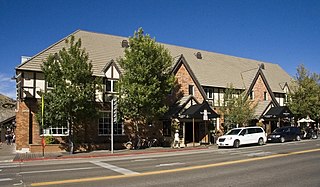
The Wort Hotel was built in downtown Jackson, Wyoming, United States by brothers John and Jess Wort, who were significant figures in the transformation of the economy of Jackson Hole from ranching to tourism. The somewhat Tudor-style building was the first luxury hotel in Jackson. The two-story building features brick facing, with half-timbering and stucco on the second floor and a series of gables facing the street.

The Bocock–Isbell House is a structure within the Appomattox Court House National Historical Park. It was registered in the National Park Service's database of Official Structures on June 26, 1989.
Tourtellotte & Hummel was an American architectural firm from Boise, Idaho and Portland, Oregon.
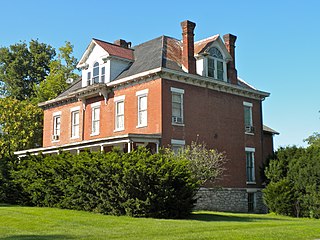
The John N. and Mary L. (Rankin) Irwin House is a historic building located in Keokuk, Iowa, United States. It was individually listed on the National Register of Historic Places in 1999. In 2002 it was included as a contributing property in The Park Place-Grand Avenue Residential District.

Kirks Mills Historic District is a national historic district located at Little Britain Township, Lancaster County, Pennsylvania. The district includes 12 contributing buildings in the village of Kirks Mills. They are Jacob Kirk's Mansion House, Brick Mill / Kirk's Mill, the brick miller's house, stone and log barn converted to a residence in 1975, Joseph Reynold's House (1825), Eastland Friend's Meeting and Tenant House, Ephriam B. Lynch House (1880s), Harry Reynolds House, Manuel Reynolds House, Eastland School House (1838), and Log House. The Jacob Kirk's Mansion House is a three-story, brick dwelling with a two-story ell. It features a full porch on the front and right sides. Kirk's Mill is a 2+1⁄2-story brick building with a slate gable roof. It was remodeled to a residence about 1940.

The Thomas Vipham House is a historic house located near Jerome, Idaho.

The Emma J. Harvat and Mary E. Stach House, also known as the De Saint Victor House, was the home of Emma J. Harvat, who was the first female mayor of Iowa City, Iowa and the first female leader of a U.S. city with a population greater than 10,000. Harvat was a successful businesswoman who had become financially independent and retired to Iowa City at the age of 43. After arriving there she became partner in another business venture with Mary (May) Stach, establishing Harvat and Stach to sell women's clothing. Harvat and Stach had the house on Davenport Street built for them in 1919. The house was designed by Iowa City architect Orville H. Carpenter, incorporating a variety of historical revival styles, dominated by Colonial Revival.
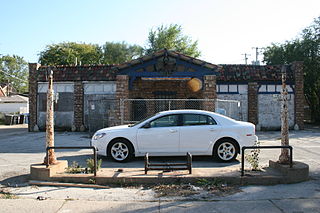
The Four Nineteen Building is a historic gas station building located at 419 E. 83rd St. in the Chatham community area of Chicago, Illinois. The station was built in 1928 by William D. Meyering and David L. Sutton, two local real estate businessmen. The station is an example of the Domestic style of gas station architecture, in which stations were designed to resemble small houses. A wooden canopy supported by brick piers covers the building's front entrance and two garage bays extend from either side, making the station part of a subtype of the Domestic style appropriately named "House with Canopy and Bays". The station's walls are built with clinker bricks laid in a skintled pattern, a combination of two Chicago construction innovations. Clinker bricks were heated at higher temperatures than standard bricks, making them swollen, dense, and differently colored; the bricks were generally discarded until the 1920s, when Chicago architects began to build with them. The skintled pattern of brickwork consisted of rough and irregular bricklaying in which bricks stuck out of and into the wall at different angles. The building's parapet roof is tiled with multicolored Mission style clay tiles, which were thought to pair well with skintled walls by architects of the era. Gas stations constructed from the 1930s onward generally had more functional designs, and as of 1999, the Four Nineteen Building was one of only sixteen Domestic-style gas stations remaining in Chicago and one of three with both a canopy and bays.
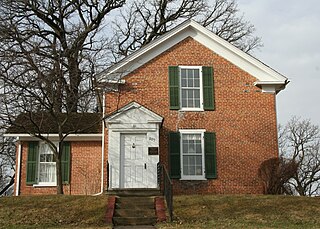
The Orville P. and Sarah Chubb House is a historic house in Fairmont, Minnesota, United States. Built in 1867, the Chubb House is the oldest residence standing in Fairmont, and the only surviving house known to have been built with brick from Fairmont's first brickyard. It was the home of prominent homesteader Orville Chubb, who was the community's first physician. The house is an example of a property associated with the early Yankee American development of southern Minnesota town sites. The house was listed on the National Register of Historic Places in 1995 for having local significance in the theme of exploration/settlement. It was nominated for its connections to the founding of Fairmont and for representing the Yankee settlement of southern Minnesota towns.

Eagle Mountain House is a historic resort hotel at 179 Carter Notch Road in Jackson, New Hampshire. Built in 1916 and enlarged in 1929, it is one of the few surviving grand mountain resort hotels in the White Mountains of New Hampshire. The hotel is currently a member of Historic Hotels of America, the official program of the National Trust for Historic Preservation. It was listed on the National Register of Historic Places in 1990.
The United States Post Office Coalgate is a post office in Coalgate, Oklahoma. It contains a mural, Women Making Pishafa, painted by artist Acee Blue Eagle. The post office is listed on the National Register of Historic Places.

The Wells-Jackson Carriage House Complex is a well-preserved complex of estate outbuildings at 192-194 Jackson Court and 370 Maple Street in Burlington, Vermont, United States. Built in 1901 as part of a larger estate, the complex includes a carriage house, tack house, and coachman's quarters of a quality unrivaled in the state. Obsoleted by the advent of the automobile, the buildings have been converted to residential use. They were listed on the National Register of Historic Places in 1982.
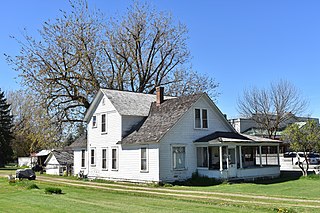
The Bushnell-Fisher House in Eagle, Idaho, is a 1+1⁄2-story Queen Anne house constructed in 1909. A front facing gable features decorative shingles above dormer windows, and left and right side gables are more fully decorated. Turned columns support an off center porch with hip roof. The house was added to the National Register of Historic Places in 2011.
The Cecil Ranch, in Grimes, California in Colusa County, California, United States, was listed on the National Register of Historic Places in 2004. The listing included seven contributing buildings and a contributing structure on 1.7 acres (0.69 ha).

The John Pearce House is a historic house in Albuquerque, New Mexico. It is notable for its architecture and as the only extant house on the Downtown section of Central Avenue, which is otherwise occupied entirely by commercial buildings. The house was built in 1905 by Dr. John F. Pearce, one of the city's first physicians. The contractor, Wallace Hesselden, also built the Henry Mann House the same year. After Pearce moved out of the house in 1933, it was used for various functions including a boarding house and chiropractic clinic. In 1982, the house was renovated and converted to office space. The architect for the renovation was Antoine Predock. The property was added to the New Mexico State Register of Cultural Properties and the National Register of Historic Places in 1980. It is next door to another historic structure, the Skinner Building.

The Henry K. and Mary E. Shaffer House in Loveland, Colorado, United States, is an English-Norman cottage which was built in 1928–1929. It was designated a City of Loveland Historic Landmark in 2006 and was listed on the National Register of Historic Places in 2007.

The Orville T. Waring House is a historic building located at 900 Park Avenue in the city of Plainfield in Union County, New Jersey. Built in 1881, it was added to the National Register of Historic Places on May 14, 1979, for its significance in architecture, commerce, and industry. Orville Taylor Waring was an oil industry pioneer. The house was added as a contributing property to the Van Wyck Brooks Historic District on December 10, 1985.
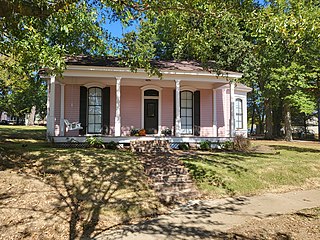
The Captain H.P. Farrar House is a historical home located in Jackson, Tennessee. On April 15, 1982, it was placed on the National Register of Historic Places for both its architectural and historical significance. It is located at the corner of Clay and W. Orleans Streets.



















